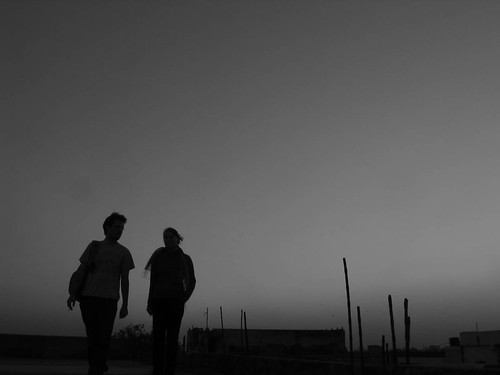A couple of weekends ago I took a trip to Jodhpur with Dorin my housemate (I've stolen his photos and uploaded them here).
Jodhpur is in the western part of Rajasthan, which is quite barren and on the edge of a large desert called, from memory, the Thar. The landscape reminded me of Australia; a lot of low, scrubby brush, a few trees, a lot of dust. Like SA or inland victoria. Bloody hot too.
Jodhpur is known as the blue city for being painted blue. Original, huh? Apparently the mineral that made the paint blue was supposed to repel mosquitoes.
The Rajasthan culture of the last 1000 years is steeped in chivalry and sacrifice, and is very similar to the European culture of the middle ages. A number of Maharajs ruled different parts of the state from their forts, frequently fighting each other on points of honour, and later battling first the Mughal (Muslim) and later the British colonisers. They were known to battle against overwhelming odds and when defeat seemed certain, men rode out to their death in waves while women and children killed themselves by jumping on huge funeral pyres.
Actually, women had a habit of dying this way; when the Maharaj died, Maharaja's donned their wedding dresses and rode through the city praying and giving away their things to the poor. Finally they arrived at their husbands funeral pyre, where they burned themselves to death, in the legends without uttering a word. One of the forts we visited had the saffron handprints of all the Maharaja's who had commited this act.
I have to say, I love the way Rajasthani women dress. In stark contrast to the barren wilderness they live in, their clothes are full of the brightest colours you can imagine.
Often though you will never see their faces - they have a strange way of pulling a veil in front of their faces when they are in public around strangers. Apparently this habit started as a reaction to Muslim invaders - Rajasthani's did not want their women looked at by their invaders. Or possibly, it was something taken from Muslim culture - there seemed to be two different interpretations. The forts and palaces are also designed in a certain way so that one can see out, but not in, a way to allow women to see out and observe the city, without compromising their modesty.
The highlight in Jodhpur was taking a little tour around the countryside there. We got to see a few different communities and the different ways they lived; farming, pottery, carpet making, etc. We also got to see them prepare opium, which has been used for centuries in Rajasthan. Most people in the countryside apparently take small amounts frequently, even daily, generally with their tea.
Subscribe to:
Post Comments (Atom)

No comments:
Post a Comment